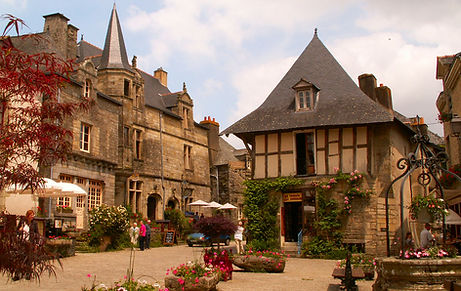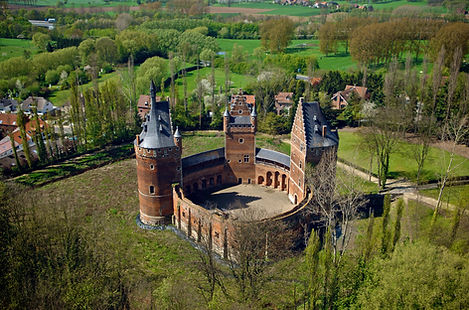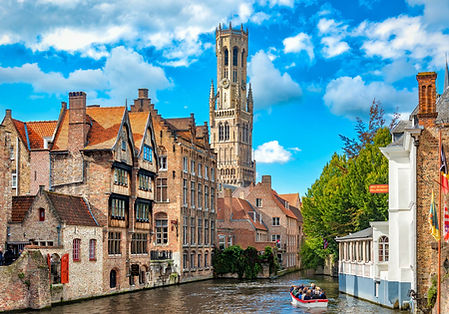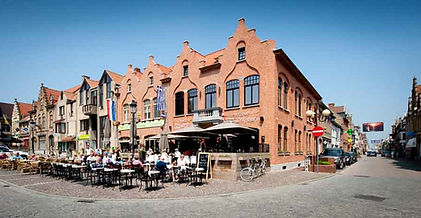Netherlands Tour
A suggestive tour of the Netherlands that will lead us through breathtaking landscapes, discovering the wonderful places of the land of tulips and windmills. We will go through the Ardennes to get to Flanders where we can admire the majesty of the North Sea. At this point we will be transferring to Amsterdam, the capital of northern Europe, where we will finally visit the famous windmills and the infinite expanse of tulips.
First day: Rochefort, Dinant, Namur
Path: Easy
Distance: about 60 Km.
Difference in altitude: about 350 mt.
Journey time: about 4 hours (excluding visits).
Journey time whit stops: about 6 hours (including visits).


Rochefort: is a city located in the south east of Belgium, in the province of Namur. Very close to the Ardennes, is washed by the river Lomme. It is especially appreciated for its origins dating back to the Roman period. To date its inhabitants are not numerous, a factor that places the resort in a quiet and unhealthy environment, surrounded by fertile and well-groomed nature.


Dinant: is a municipality in the district of Namur in Belgium. It is located on the upper course of the Meuse, in French-speaking Belgium, in a narrow valley and is dominated by a fortress. Characteristic is the collegiate made of black stone. A born in 1814 Dinant Adolphe Sax (Antoine Joseph Sax), musical instrument maker and inventor of the saxophone or sax. In the profile of the city of Dinant you can see the Collegiate of Notre-Dame, with its characteristic bell tower. Among its many features, the collegiate church has a blue stained glass window among the highest in Europe, the eighteenth-century pulpit and the Romanesque portal.
Namur: is a Belgian city of about 100,000 inhabitants, capital of Wallonia, capital of the province and the Catholic bishopric, located at the confluence of the rivers Meuse and Sambre. The center was built for military purposes in the Merovingian era to guard the valley of the Meuse: the main monument in town is the Cathedral of St. Alban, who between 1751 and 1763 took on its current neoclassical structure (contains some paintings by Jacob Jordaens and Antoon van Dyck, together with the Flemish Laurent Delvaux sculptures); Important also the Musée des Arts Anciens du Namurois and the Musée Archéologique. The strong bastion that garrisoned the Sambre (the Citadel), scene of several sieges, and that keeps track of major military engineers like Vauban and Menno van Coehoorn, from 1891 has been transformed into a park. Namur, a white weapon spread in the nineteenth century, appears to have been built in the town and used in the city itself during the French invasion of Belgium (1792-1794). The Citadel of Namur is a majestic fortress located at the confluence of the rivers Sambre and Meuse. Originally a Roman structure, it was rebuilt, modified and expanded several times over the centuries. Today is one of the largest fortresses in Europe and is ranked as the most important heritage of Wallonia.

Second day: Waterloo, Beersel, Brussels
Path: Medium difficulty
Distance: about 75 Km.
Difference in altitude: about 350 mt.
Journey time: about 4 hours (excluding visits).
Journey time whit stops: about 6 hours (including visits).


Waterloo: is known throughout the world for the latest epic battle led by Napoleon Bonaparte. Here it took place one of the battles that changed the course of history, which saw Arthur Wellesley Duke of Wellington winner. The Lion Hill, where the lion stands, a symbol of Great Britain that rests on a paw on the globe. At the top of the hill is accessed by the long staircase consisting of 226 steps, from where you can span the entire battlefield thanks also to an illustrative table showing the arrangement of the various decks. The Wax Museum, which depicts the characters, the wax figures were created in 1949 by the artists of the Grevin Museum. Inside the museum are also visible various documents and testimonies and many authentic finds. The Battle Panorama was opened to the public in 1912 and features a circular canvas that is 110 meters long and is 12 meters wide, showing some of the events of the battle.


Beersel: Less than ten kilometers from Brussels is Beersel. The fortified medieval castle dates back to the 12th century and is located in a wooded area and is surrounded by a lake that is crossed by a drawbridge. In honor of this fortress, Victor Hugo wrote some verses. Beersel Castle is one of the most famous medieval fortifications in Belgium. Like most Flemish castles for its construction, red bricks were used instead of stones. The flat landscape forced the local lord to create a great moat, erecting high walls and mighty towers, remarkably high compared to other Belgian fortresses dating back to that period. To visit there is also the brewery 3 Fonteinen. For beer lovers, it's a good opportunity to make a tasting of different types of Belgian beer, including fruit varieties.
Brussels: metropolitan area of Belgium which houses all'inc irca 2.6 million inhabitants. Much of the area is administered by the Region of Brussels-Capital, divided into 19 municipalities, including that of the historic center, the City of Brussels. The city, however, also extends beyond the boundaries of the region: various municipalities of Brussels' suburbs, administratively part of the Flanders region, are part of you ssuto urban Brussels. Brussels is considered to be the de facto capital of the European Union as the seat of various institutions, including the European Commission, the Council of the European Union and the European Parliament. For Evere also it houses the NATO headquarters. Brussels also hosts the Committee of the Regions and the Economic and Social Committee. The first nucleus of the city of Brussels would be built in the sixth century AD to the initiative of the bishop of Cambrai, as a strategic point of connection between the cities of Cologne and Bruges. Subsequently, its history was indissolubly tied to the fate of the Flemish region, passing through the struggles for dominance between Austria, Spain and France. In 1477, when it became the capital of the Austrian Netherlands, it was considered one of the most attractive and wealthy cities in Europe, thanks mainly to its commercial activities, focused on tissue traffic. In 1567, in order to suffocate the autonomous motions, the Spanish Duca d'Alba adopted strongly repressive methods, leading to the decapitation of 1,800 people. The Spanish government, which continued throughout the 17th century, was ineffective and disastrous, and caused a rapid economic downturn, which in turn led craftmen and merchants to the uprising. Independence after a period of Napoleonic occupation and after fifteen years of association with the Court of Holland was finally reached in 1830, following a rift that broke out in the streets on 25 August.

Third Day: Gand, Bruges
Path: Medium difficulty
Distance: about 90 Km.
Difference in altitude: about 100 mt.
Journey time: about 4 hours (excluding visits).
Journey time whit stops: about 6 hours (including visits).



Gand: is a city in Belgium, the capital of the East Flanders. It covers an area of 156.18 km², And in 2012 counted 251,133 inhabitants, which made it the third most populated city in Belgium. Gand was the capital of the ancient county of Flanders, often a rival in Bruges, and the hometown of Charles V. Important railway junction, also has a seaport that connects to the North Sea through a series of canals. The city's motto is in Latin Fides and love, fidelity and love. The local dialect 'Gantois' is one of the most typical in Belgium. Capital City of Eastern Flanders, located on several islands formed by the Lys river confluence with the Scheldt. A city of culture, with an important university, and industry with mechanical, chemical, rubber, food and textile manufactures. Every five years, the last week of April there is the "Floralies of Gand", one of the most important and renowned events for the floriculture enthusiasts around the world.
Bruges: is a city in Belgium, the capital and largest city of West Flanders, in the Flemish Community. Permanent seat of the College of Europe and a Catholic diocese, the medieval historic center was proclaimed UNESCO World Heritage Site in 2000. In 2002, the city was the European capital of culture along with the Spanish city of Salamanca. There have been few traces of human activities before the Gallo-Roman period. The first fortifications were built after the conquest of Menapii by Giulio Cesare in the first century BC The Franks took over the Romans in the region around the fourth century and administered it as the Pagus Flandrensis. The 9th century viking vandalism incurs Baldwin I, Count of Flanders, to reinforce existing fortifications to re-establish maritime trade routes. At the same time begin to be minted coins stamped with, for the first time, the name Bryggia. Bruges is undoubtedly one of the jewels of northern Europe, offering the visitor a rich combination of Flemish architectural history and splendor in a compact, accessible city center on foot. The places from which to start exploring the city include the market square, the Markt, on which stands the colossal figure of the belltower "Belfort", and Burg, another square within walking distance from the Markt, which has a number of beautiful buildings, which together summarize a kind of journey through the history of European architecture.

Fourth Day: Nieuwpoort, Knokke-Heist
Path: Easy
Distance: about 70 Km.
Difference in altitude: about 0 mt.
Journey time: about 3 hours (excluding visits).
Journey time whit stops: about 5 hours (including visits).


Nieuwpoort: is a Belgian municipality located in the Flemish province of West Flanders. The municipality comprises the city of Nieuwpoort proper and the towns of Ramskapelle and Sint-Joris. In Nieuwpoort the Yser River flows into the North Sea. He obtained the status of the city in 1163 by Count Philip I of Flanders. There was in 1600 the battle of Nieuwpoort, between Dutch and Spanish. During the battle of 'Yser, in the First World War, Karel cogge opened twice closed the mouths of the Yser River to flood the interior, thus stopping the advancing German army.


Knokke-Heist: is a Belgian municipality located in the Flemish province of West Flanders. It is a seaside resort on the Belgian coast of the North Sea and one of the most important cities for Belgian tourism, especially from middle and middle classes. Knokke itself is divided into several areas: Duinbergen, Albertstrand, Knokke Center, Le Le Zoute and Zwin. The town is also located one of the terminus of Kusttram, 62 km tramway that runs along the Belgian coast in De Panne. The Zwin nature reserve is one of the most important of the coast, and one of the biggest in Belgium. One of the major attractions is the Butterfly Garden (De Vlindertuin) that includes a collection of butterflies from around the world, more than 300 of the reviewed butterflies including the butterfly passion, the tropical night, the pasha with two tails and the morpho Cypris. On the waterfront there are restaurants and, to be remembered, is the first establishment near the dam that was opened in 1896 in the ancient guard body of a French fort of the Napoleonic period. Among the specialties of this corner of Flanders at the border with the Netherlands we find the famous waffles Moeder Siska (Siska Mom) in the shape of clover with five hearts.
Fifth day: Transfer to Amsterdam
Sixth day: Amsterdam, Zaanse Schans, Edam, Volendam
Path: Easy
Distance: about 60 Km.
Difference in altitude: about 0 mt.
Journey time: about 3 hours (excluding visits).
Journey time whit stops: about 5 hours (including visits).



Amsterdam: is the capital and largest city of the Netherlands, in North Holland provin cia. The area in the center of the city surrounded by canals of the twelfth century is from the 2010 World Heritage Site. Amsterdam has one of the largest Renaissance centers in Europe. Numerous buildings dating from the 16th to the 17th century, also known as the Golden Century, are now considered historic monuments and are placed around a series of concentric polygonal channels. The city is famous for hosting the Rijksmuseum (State Museum), the Van Gogh Museum, the Concertgebouw, the Rembrandthuis, the Anne Frank House and a huge number of bicycles. Amsterdam is also famous for its red light district, De Wallen, and its numerous coffee shops authorized to sell marijuana and cannabis derivatives. The city of Amsterdam has 4,630,000 tourists a year, making it one of the most visited capitals in Europe. The main tourist destinations are: Dam Square is a historic square on the first dam built dell'Amstel and par excellence the city center, they show considerable monum bodies. Amsterdam Channels. The entire historical center of the city consists of a long network of canals more than one hundred kilometers, about 90 islands and 1,500 bridges. The three main canals, Herengracht, Prinsengracht and Keizersgracht, dug in the seventeenth century, during the Dutch Golden Century, form a concentric belt around the city known as the Grachtengordel. Along the canal is no 1550 monumental buildings. The area included in the belt of the seventeenth century channels within the Singelgracht, which includes the Prinsengracht, Keizersgracht, Herengracht and Jordan, is inserted in the list of UNESCO Patrimoni.
Zaanse Schans: is a small community of 40 homes located north-east of Amsterdam, on the shore of the river Zaan. It is located in Zaandam, in the municipality of Zaanstad in North Holland. In the 18th century this region was an industrial area with over 700 windmills. Many of these historic mills and some houses are still in excellent condition and represent a strong tourist attraction, so that some are expected to visit them in their interior. In 2007 a new mill was built on the mold of the historic ones, which inside shows a video of construction operations. Zaanse Schans is known for its mills. In recent centuries in the area (called Zaanstreek) existed more than 1000. The first mills were in 1321 in Jisp and centuries after several mills were built nearby, and were exploited to move water and grind flour in the areas named Zaanstreek.


Edam: is a town in the south-east coast Ola nda North, located in the Waterland region and overlooking the Markermeer, south of the trac tor 'IJsselmeer. The town, once a fishing port for whaling, is internationally famous for its namesake cheese. The main economic activities of Edam are now the industry, fishing, 'agriculture and livestock. The Edam cheese produ ce since the sixteenth century. It is characterized by the coating wax (yellow and red for the Netherlands abroad, used to distinguish it from Gouda).
Volendam: is a quiet fishing town overlooking the Zuiderzee, a beautiful marina, an endless promenade and many restaurants, clubs and shops that frame the center. Famous for fish (mainly eels), and for traditional costumes of the inhabitants. The name Volendam has a historical origin and comes from the term "dam", and refers to that made in 1357, which trapped the sea and marked the fortune and commerce of the fishing village. The ideal is to explore it just starting from the small and well-preserved harbor, admiring the nautical masterpieces here moored and greeting the statue of "grandfather" one of the founders of the village. It is always at the side of the marina that is located the small Volendam Museum on stilts, for a journey into the history of the seaside town, between traditions, customs and images of the times that were.

Cost per person (in a double room) for groups of 18/20 participants:
€ 1789.00 excluding the month of August and September to which personalized quotes will be made.
Single room supplement: € 25.00 per day/person
Services included:
-
Overnight stays in Hotel/B & B with half board (drinks excluded);
-
Packed breakfast;
-
Cycling guide;
-
Technical assistance for luggage transport.
Services not included:
-
During the bike excursions you can have lunch in a restaurant (average price of about € 40.00/45.00 per person, includes: starter, first course, second course, fruit, drinks are not included);
-
Tickets for archaeological sites;
-
Bicycle rental, helmet and accessories;
-
Possibility of transfer round-trip (by reservation);
-
Extras and everything not included in "included services".
On request Custom tours.
For more information and booking, write to: info@irentbike.com
For this tour, the Rent Bike recommends bikes in excellent condition and the use of appropriate cycling clothing.

